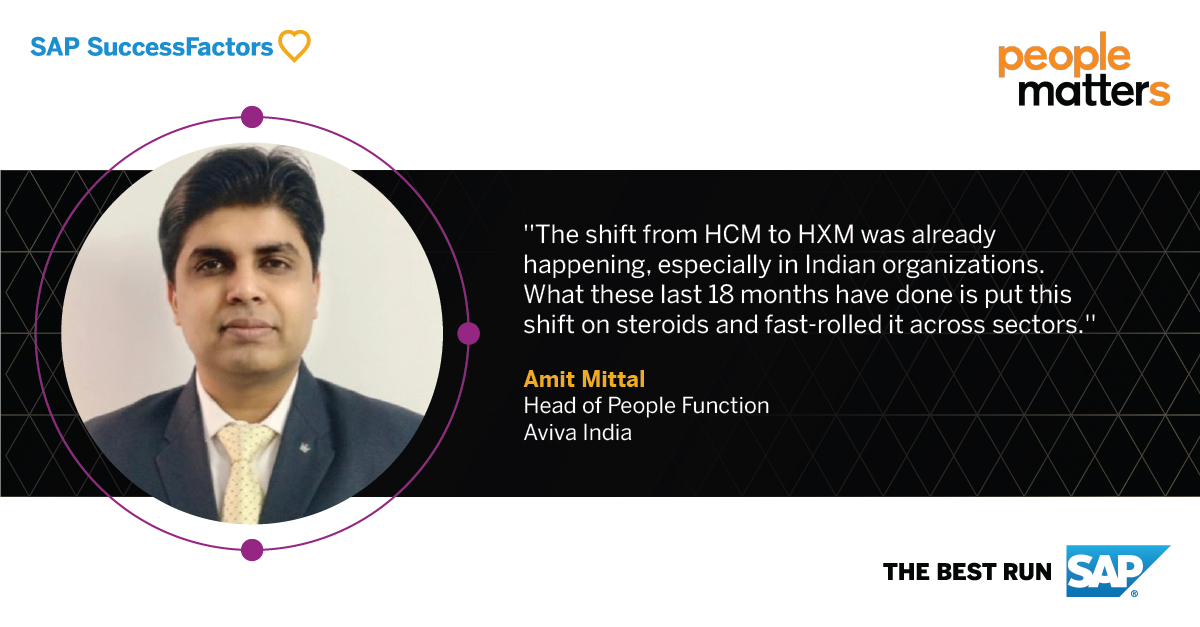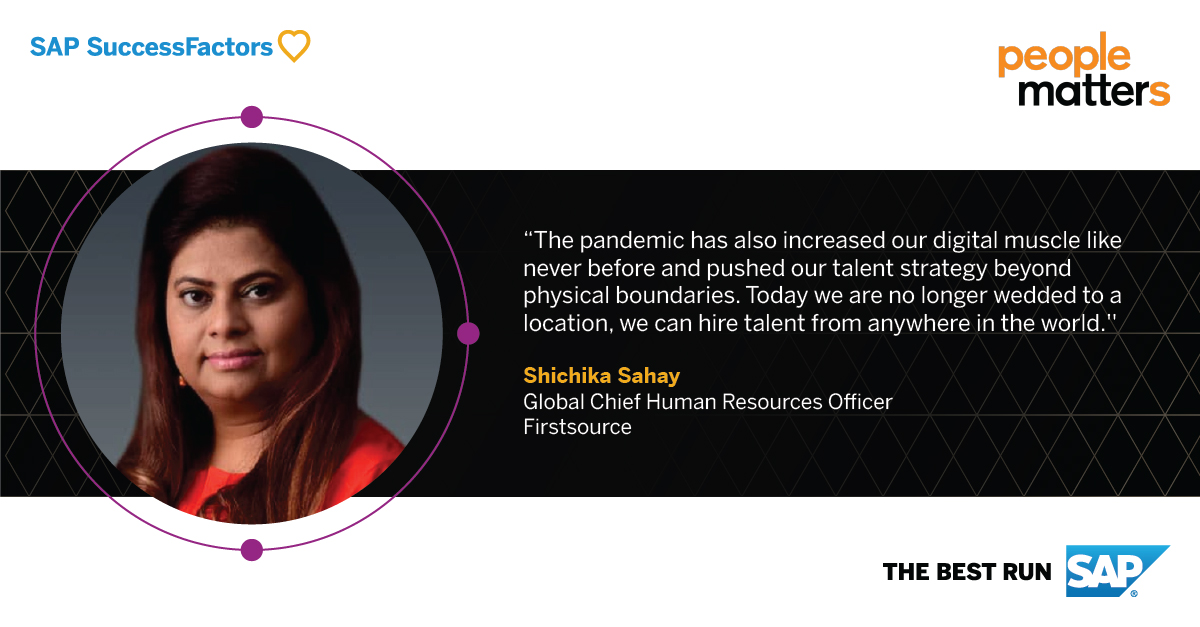2020 ushered us into a new way of working. Organizations are now moving to investing and setting up infrastructures to provide a superior work experience to their people– Hybrid 2.0. SAP organized the SAP HR Connect 2021 to throw some much-needed light on how we can design employee experiences for the hybrid 2.0 world that are holistic, progressive, agile, technology-driven, and most importantly, more human!
The event brought together talent leaders for a Power Panel Discussion to shine the spotlight on the ongoing shift from HCM to HXM in the vaccine economy. Moderated by Cindy Scholts, Virtual Learning and Development Manager, People Matters, the panel included – Shuchika Sahay, Global Chief Human Resources Officer, Firstsource; Nitinchandra Shende, Head – People Operations and Corporate Initiatives and Ashish Mittal, Head of People Function, Aviva India.
While reflecting on the current work scenario, the panel answered some critical questions on how human experience management principles will occupy center stage as tools to engage employees and how they are redefining EX to align business outcomes for a hybrid world.
The shift from HCM to HXM
Amit Mittal: The shift was already happening, especially in Indian organizations. What these last 18 months have done is put this shift on steroids and fast-rolled it across sectors. Identifying employee needs and managing them is an essential part of staying competitive in the market.

It is said, “people share a good experience with a friend, but a bad one with the whole world”. As an organization, this has driven us to focus on people who are leaving to ensure that they have a good experience because we see them as our employee champions.
Another shift that has happened within organizations is – instead of thinking of our employees as a captive population, we have started looking at our employees like our customers. Previously, we used segmentation sparsely, e.g., as part of the dashboard building process, but now we are refocusing on segmentation to find different ways to improve employee experiences.
It’s become abundantly clear that one size doesn’t fit all. And it is essential to get in touch with the ground reality for each employee to understand their needs and take up initiatives and interventions that support them individually.
Nitinchandra Shende: From an HCM point of view, during the pre-pandemic era, we all had standard operating procedures (SOP’s) in place for processes and, everything was documented in a pre-determined manner. The pandemic shattered all boundaries within which we previously operated, creating chaos in terms of how we live through each of these events/experiences.
When the first lockdown was announced, the primary priority was to ensure the safety of every employee and enable their contributions. As the scenario evolved, we experienced more and more life events that we could not have imagined in the past. None of these events/experiences were a part of our SOP’s till March 2020. But we had to start looking at them from an organizational perspective. This brought about the shift from procedural to experience-focused aspects and made it essential for us to start looking for solutions and processes that are more individualistic and relevant to the current needs.
Shuchika Sahay: There are a lot of interesting shifts that have been accelerated – not just because of the pandemic but due to a lot of other aspects as well. Technology, for example, has been accelerating a lot of things in the societal space. Digitization has simplified even the most basic of processes. So now, when it comes to organizational processes, we look for the same kind of convenience.
Another critical shift has been the “rise of the state”. To control the pandemic’s spread and manage its wide-ranging impacts the state has demonstrated a critical role in shaping responses, strategies, and approaches in tackling problems at a more individual level. When states act on account of employees, we see a shift in terms of employee behavior itself. And this brings with it some level of pressure on HR and company leaders to take a closer look at the nuances and need for personalization.
Thirdly, the pandemic has also exposed some glaring gaps in organizational offerings. E.g., DNI has been a critical aspect of the organizational construct for the past two decades. But it is only during the pandemic, that organizations have realized that most of their female employees are the primary caregivers, and they hardly have any infrastructure in place to support them or their needs. Organizations are slowly but surely making an effort to step back and find new ways to tackle problems that previously flew under the radar.
HR is no longer an internal function. Social media has given everyone an outlet for a new kind of employee activism and feedback. Adding to the pressure on HR to shift focus on creating better employee experiences. They no longer have the luxury to design processes from a single perspective and should take into account the end-user perspective.
Key areas of focus for redesigning EX
Nitin: In the pre-pandemic world, we could generalize a lot of things and could easily divide employee lifecycles into various phases – recruitment, onboarding, etc. And simply build experiences around these certain events. As we live through the pandemic things have changed. From an HR perspective there are 3 things that we need to look at in particular:

- Listening to our employees – Every employee is going through a different life experience and the more we listen, the more we will understand what this experience means to them.
- Creating a culture of trust – With the current “work-from-anywhere” scenario, it is all about written communication. This causes a certain level of limitation in understanding expectations. We need a culture of trust so we don’t end up creating perception-driven behaviors but work together as a team.
- Making HR processes agile – While we have little to no experience and SOP’s for most scenarios we are experiencing today. We need to have 1 rule book that guides our response to every scenario in an unbiased manner while recognizing the need for agility in work processes.
Amit: While we all talk about change, but as companies, we are the worst at making changes when we have a set of processes in place for each experience. While trying to redesign for the last 18 months we focused on listening to the needs of our people and quickly adapting initiatives that help them. E.g., to help our employees through the grief and chaos of the second wave, we quickly put together what we called a “Happiness Campaign”. Instead of focusing on productivity and sales, this campaign brought to employees practical scientific ways to address their state of mind, helping them bring back their happier selves to work.
Listening without action does not help anyone. It is the actions taken with the right intent that truly bring about the shift needed in the organization and its people.
Technology’s role in redesigning EX
Shuchika: To think about it we can’t even imagine a life without technology anymore. Technology today holds the key to creating a global workforce, to human interactions and connections. Technology has proved to be a very capable enabler for every process you need to design to scale, hyper-personalize, and deliver on time.
Our organization has defined its cloud strategy, and one of the things HR is doing is leading by embracing HXM that’s cloud-led. It is important to access well-defined, benchmarked processes that you can drive within, to help your organization move forward and be more people-centric. The biggest benefit of technology has been its ability to define experiences and scale them across the organization.
Another key benefit has to be the kind of data analytics that is now possible due to technology. Today it is possible to analyze data and get answers from it almost immediately. This is a great boon to CEOs and decision-makers and gives organizations a competitive edge they didn’t have before.
The pandemic has also increased our digital muscle like never before and pushed our talent strategy beyond physical boundaries. Today we are no longer wedded to a location, we can hire talent from anywhere in the world.

Leveraging EX to thrive in a vaccine economy
Nitin: Even before the vaccine economy, HR’s focus on business outcomes never entirely shifted and it never will. On the contrary, HR’s role in enabling business outcomes has become even more important than it ever was. E.g., during the first wave through March 2020, we had a lot of new joinees in a dilemma about the validity of their joining contract and if they will even be honored. We resolved this by revamping our complete onboarding process. What was traditionally a once-a-week event has now turned into an anytime-anywhere onboarding system that simplifies and eases these anxieties.
As an HR function in the vaccine economy, we should not get mixed up in whether our actions should focus on ‘customers-first or employees first. Within our organization, we use a phrase – “customers first, but employees always”. We use this frequently to navigate any ambiguity we have during any type of conflict resolution and while aligning all processes and practices around it.
1 best tip to thrive in the vaccine economy
Amit: Be empathetic to people and understand what they are saying.
Shuchika: Co-create! HR longer has the luxury to be a function that designs alone. Instead, we need to build communities across the organization to deliver experiences.
Nitin: Empathy is the key to surviving and thriving in these uncertain times.
Check out more posts:
Evolving Employee Experience from HCM to HXM in Hybrid 2.0 – SAP India News Center
CEO’s Perspectives on the Changing People Paradigm – SAP India News Center
Meeting Business Priorities in a Hybrid World – SAP India News Center



